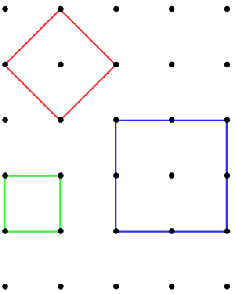Grid lockout
Problem

Investigate the areas of squares formed by joining points on a square grid and show that it is impossible to construct any square whose area is (4n + 3) where n is an integer.
Getting Started
Student Solutions
Well done to Andrew (Wilson's School), Shibon (North London Collegiate School), and Jonathan (Oakwood Park Grammar School), who had the right answer to the situation when the squares are parallel to the lines on the grid.

Shibon concluded that:
It is impossible to have a square whose area is (4n + 3) as all square numbers when divided by 4 have remainder of either 0 or 1 as shown below. No square number divided by 4 is left with a remainder of 3.

Andrew sent us a good proof:
Let n be the integer we wish to square.
If n is even... let n = 2m
\begin{eqnarray} n^2 &=& 4m^2 \end{eqnarray}
Therefore n is divisible by 4.
If n is odd... let n = 2m+1
\begin{eqnarray} n^2 &=& (2m+1)^2 &=& 4m^2 + 4m + 1 &=& 4(m^2 + m) + 1 \end{eqnarray}
which must therefore be one more than a multiple of 4.
Therefore any integer, when squared, will leave a remainder of either 0 or 1 when divided by 4. Hence it is not possible to have a remainder 3.
For the situation when squares make angles with the lines of the grid, we have a good answer from Daniel (Savile Park).

Therefore:
Teachers' Resources
Why do this problem :
In this problem it seems something of a surprise that the square areas which can be constructed should apparently be constrained in this way (you cannot make an area of $4n + 3$ square units). It feels as if there ought to be more freedom. This problem encourages analysis and the forming of conjectures, and especially justifying or accounting for pattern.Possible approach :
Ask the group to draw a variety of squares using paper with dots, to calculate the area of each and to keep a record.
Ask the group to organise their record in a way they think useful, and invite conjecture about the situation.
Ask the group to look at the way they decided to organise their results and to decide what additional results might usefully be acquired next.
Ask members of the group to share their thoughts.
Once the proposed additional work has been done again invite conjecture about the situation: any comment, or things to try.
Suggest to the students that they look at the remainder when the area values are divided by 4, leave some thinking time before again inviting conjecture.
Key questions :
- What are the freedoms the problem gives you and what are the constraints?
- What does this problem invite you to explore?
- How can you organise your exploration so that analysis can follow most easily?
